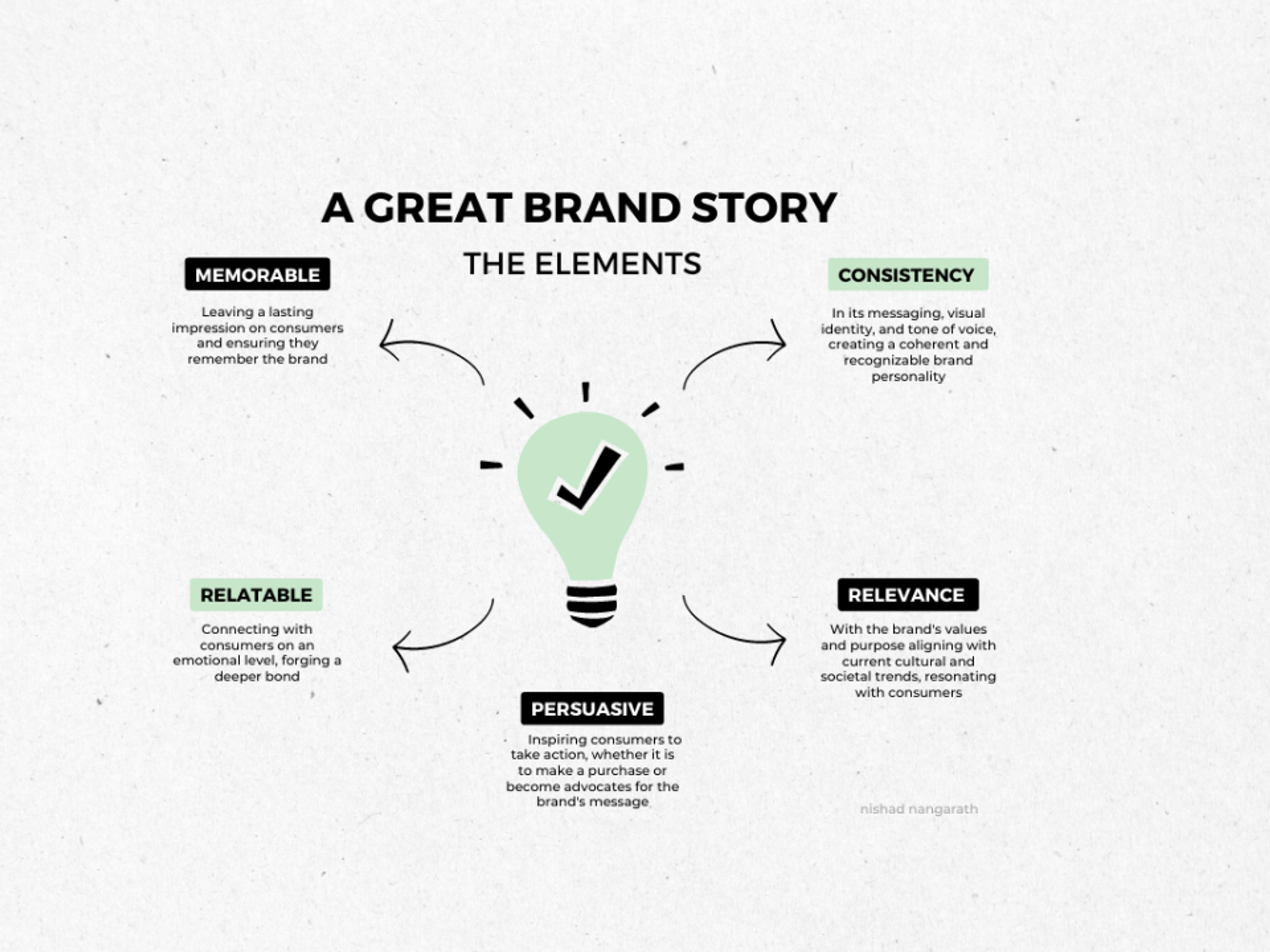The captivating force of storytelling has remained unchanged since ancient times. This truth holds just as strong in the realm of branding.
Creating an engaging brand narrative is indispensable for any serious business owner hoping to succeed in a bustling market.
Several strategies can be employed when telling your unique brand story, from identifying your core values and mission to using visuals and imagery to capture attention.
What Is a Brand's Story?
Brand storytelling is a way to capture the essence of your brand and convey it in an authentic, engaging, and memorable way. It involves weaving visuals, narratives, and emotions to connect your brand with its target market or audience.
An engaging brand story captivates audiences, significantly boosting brand awareness by making the brand memorable and relatable, thereby increasing its visibility and recognition in the market.
Creating an emotional connection between your brand and its customers through storytelling is what brand storytelling is all about.
By sharing deeply resonating narratives, you can showcase your brand's personality and forge meaningful emotional connections with people. This, in turn, fosters a favorable perception of your brand and cultivates customer loyalty.
Source: Rain Bennett on Unsplash

Factors to Consider When Crafting a Successful Brand Story
Audience Engagement
Audience engagement is an essential element in crafting a compelling brand story. By engaging with your target audience and understanding their wants, needs, values, and preferences, you can create stories that truly resonate with them.
Engaging directly with your audience allows you to build relationships and gain valuable insights into crafting a compelling story that will capture their attention.
When engaging with customers, it’s important to keep the conversation going by asking open-ended questions and encouraging them to share their experiences.
This will help you better understand their perspective and use it to inspire your stories. Investing in customer feedback surveys or focus groups can help you better understand what resonates with them and what stories will best represent your brand.
Additionally, staying active on social media can effectively engage with audiences and organically promote your brand story. From using hashtags to initiate conversations to creating polls as part of storytelling campaigns, there are many ways to interact with customers on social media platforms.
These strategies can help keep customers interested in your good brand story while gathering meaningful feedback they can use when crafting future stories.
Source: LinkedIn

By engaging thoughtfully with customers and understanding their points of view, brands can create stories that reflect their mission and values while profoundly connecting with their target audience.
Ultimately, strong customer engagement creates trust between brands and customers, which helps foster loyalty over time and encourages more people to invest in the brand’s story.
Emotion and Creativity
Emotion and creativity are two essential components of a successful brand story. By evoking emotions, brands can create an intimate connection with their customers and draw them into the brand’s world.
At the same time, injecting creativity into the narrative helps to keep audiences engaged and excited by unexpected twists.
When creating stories, brands should consider how they want to make their audience feel. For example, do they want to evoke a sense of nostalgia or inspire enthusiasm?
Knowing this will help determine which story elements to include and which visuals and colors to use to convey the desired emotion effectively.
Additionally, creativity is key to captivating audiences. Instead of simply telling the same old stories, brands should find new ways to tell their stories that surprise their customers and bring fresh perspectives on familiar topics.
This could mean introducing unexpected characters or scenarios, playing with mediums such as video or animations, using data stories, or incorporating pop culture references that tap into current events.
Source: No Revisions on Unsplash

Overall, emotion and creativity go hand in hand when crafting powerful brand stories that engage customers deeply emotionally.
By understanding how customers want to feel and injecting creativity into the narratives, brands can create great brand stories that leave lasting impressions on their target audiences - helping to foster loyalty over time.
Authenticity and Reliability
Crafting a captivating, authentic brand story and narrative requires authenticity and dependability.
To build consumer trust, brands must remain authentic and consistent in their messaging. This means staying true to their mission, values, and goals while communicating this message through their stories and business storytelling.
Brands should strive to create truthful and resonant stories with their target audience. Authentic stories help customers form a deeper connection with a brand beyond the product itself, which can result in increased loyalty from them over time.
In addition to authenticity, brands must guarantee their stories are reliable and aligned with their overall communication strategy. Ensuring each story effectively supports the brand’s mission is key to creating an impactful narrative that resonates with its target audience.
By remaining consistent in tone, visuals, and content across multiple platforms, customers can better understand the brand’s message and feel confident investing in it over time.
Source: James Yarema on Unsplash

Ultimately, authenticity and reliability are essential components of compelling storytelling for brands. By creating stories that stay true to their mission while fostering trust among their customers, brands can craft narratives that capture attention while inspiring loyalty over time.
Strategies for Crafting Winning Brand Stories
Identifying Your Core Values and Mission
Crafting a winning brand identity and story starts with identifying the business's core values and mission. This involves examining what differentiates the business from its competitors and why customers should trust it.
Establishing key messages and an overarching theme around these values will help create a common thread throughout a company’s marketing materials, including its brand stories.
To start building core values and mission statements, businesses should ask themselves questions such as: “What do we believe in?”, “What is our ultimate goal?” and “How are we different from the competition?”. Having clear answers to these queries can help small businesses shape their messaging into stories that resonate with their target audience.
Businesses should also consider how they want their customers to feel when engaging with their narrative. For example, do they want them to be inspired or energized? Incorporating this message into the brand story can help business leaders ensure customers feel emotionally connected to the company.
Source: Brand Trust

Finally, businesses must ensure continuity between their mission statements and core brand values throughout all communication channels. This requires examining all customer touchpoints—from website content to customer service—for consistency in tone, messaging, visuals, etc. so that consumers have a uniform experience regardless of the channel they use.
By establishing core values and mission statements for their business and staying consistent throughout all customer touchpoints, companies can create memorable stories that genuinely reflect their identity while fostering loyalty among customers over time.
Making Use of Visuals and Imagery to Capture Attention
Using visuals and imagery to capture attention is essential to crafting a compelling brand narrative. Visuals can instantly grab the viewer’s attention and create an emotional connection between the storyteller and the intended audience.
Since visuals are processed much faster than written words, brands should strive to include compelling visuals in their stories that effectively communicate their messages. This could range from using high-quality product photos or videos to capture interest in their products to creating illustrative graphs or infographics to explain complex concepts more clearly.
It’s also crucial for brands to maintain consistency with visual elements such as fonts and colors across all platforms so customers can easily recognize the brand’s messaging when viewing stories on different channels.
In addition to visuals, incorporating engaging storytelling techniques can further bolster a brand’s story. Ideas such as using metaphors or analogies and music or video clips can help bring a story to life while keeping viewers engaged throughout its duration.
By taking advantage of both visual and auditory elements in storytelling, brands can significantly increase the impact of their stories.
Ultimately, visuals and imagery capture attention and create memorable narratives that resonate with customers over time. Brands should strive to combine compelling visuals with innovative storytelling techniques to craft unique stories that foster loyalty among their target audiences. Check out these top 10 books on branding to get valuable insights into storytelling and different approaches.
Establishing a Clear Narrative Structure to Follow
Having a clear narrative structure is critical when constructing a brand story. This structure should be the foundation for articulating the entire brand story to ensure continuity and coherence. It should also guide everything from the main idea to the flow of ideas, details, and visuals.
A well-structured narrative should incorporate elements such as an introduction, a body, and a conclusion. The introduction should include key messages that provide context for the rest of the story, while the body should contain evidence that supports these messages.
Finally, the conclusion should reinforce the main points of the origin story and provide closure for the viewer.
In addition to providing an overarching framework for stories, having a well-defined narrative structure can help brands create more impactful and persuasive stories.
To achieve this goal, it’s important to use techniques such as visualizing key lessons or utilizing powerful language that resonates with viewers. This captures attention and engages viewers meaningfully, strengthening connections with their audiences over time.
Source: Semrush

Moreover, having a solid narrative structure allows brands to be flexible when crafting their stories across different platforms. By having an established framework that applies across all channels, they can quickly create content tailored to each platform without sacrificing consistency in terms of style and messaging.
Establishing a clear narrative structure before beginning work on brand stories can help companies create engaging narratives that effectively communicate key messages while fostering customer loyalty over time.
Great Examples of Brand Storytelling
Mercedes Benz
Mercedes Benz has been the epitome of excellence and prestige for over a century. Immortalized in the classic Janis Joplin song "Oh Lord, won't you buy me a Mercedes Benz," its iconic three-pointed star emblem proudly stands for Daimler engines used on land, sea, and air.
Mercedes Benz's unrelenting devotion to perfection is reflected by its motto: "the best or nothing." From luxury cars to quality craftsmanship, when it comes to automobiles, there's no other brand quite like Mercedes Benz.
Source: Victor Sutty on Unsplash

The 2016 Merkley + Partners commercial, Snow Date, masterfully showcases the dependability of 4-MATIC 4-wheel drive. In his Mercedes Benz, a father easily takes his son to the movie theater. As he waits outside, we are left wondering if his date will show up until suddenly headlights appear in front of him, and it is revealed that she also drove another equally reliable car!
Wealth
What we did for Wealth’s brand storytelling is another exemplary case. By humanizing the estate planning process, Wealth connects with users personally. Their website features life milestone scenarios that show how their platform can help individuals prepare for the future.
Through a blend of relatable stories, vibrant illustrations, and straightforward messaging, Wealth transforms the often daunting task of estate planning into an accessible and engaging experience. This approach demystifies financial planning and builds trust and emotional resonance with the audience.
Wealth identity by Clay

Nike
Nike is an excellent example of brand storytelling. Founded in 1964, Nike has become one of the world's leading sports brands, and its iconic swoosh logo is recognized by people all around the globe. Nike's brand strategy revolves around innovation, inspiration, and empowerment.
From humble beginnings selling running shoes out of Phil Knight's car to becoming a multi-billion dollar business, Nike continues to innovate and inspire athletes everywhere with its “Just Do It” mantra.
In 2018, Nike launched a powerful campaign entitled "Dream Crazy," featuring professional athletes like Serena Williams and LeBron James sharing inspirational stories about their successful journeys. Through emotional music, vivid visuals, and compelling storytelling techniques, the ad successfully conveys a message of hope and empowerment to viewers everywhere.
Source: Maria Fernanda Pissioli on Unsplash

The combination of imagery, music, and an aspirational storyline enabled Nike to create a powerful narrative that genuinely resonates with its target audience. By encouraging people to dream big and never give up, the ad can convey a larger message about living with passion and resilience.
Read More
Conclusion
In conclusion, visuals and storytelling are essential to any brand’s story. To ensure these stories capture attention, brands should incorporate compelling visuals while utilizing innovative narrative techniques such as metaphors or analogies.
Furthermore, having a clear narrative structure can help companies craft cohesive stories across different platforms and create more impactful messages that resonate with viewers over time.
By leveraging the power of visual storytelling combined with an established framework, brands can establish strong connections with their target audiences and foster loyalty among customers in the long run.


About Clay
Clay is a UI/UX design & branding agency in San Francisco. We team up with startups and leading brands to create transformative digital experience. Clients: Facebook, Slack, Google, Amazon, Credit Karma, Zenefits, etc.
Learn more

About Clay
Clay is a UI/UX design & branding agency in San Francisco. We team up with startups and leading brands to create transformative digital experience. Clients: Facebook, Slack, Google, Amazon, Credit Karma, Zenefits, etc.
Learn more



